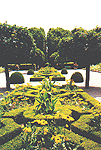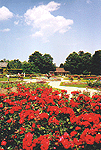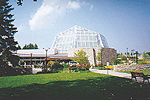
Niagara Parks Commission
School
of Horticulture
& Botanical Gardens
and
Butterfly Conservatory
The Botanical Gardens &
School of Horticulture

A view of the rose gardens at the Niagara Parks Botanical Gardens
The Niagara Parks Commission School of Horticulture/Botanical Gardens and Butterfly Conservatory are located along the Niagara Parkway approximately 2.5 miles (4 kms) north of the Whirlpool Bridge.
In 1908, Parks Superintendent John H. Jackson recommended to the Parks Commission that an educational program be developed within the Niagara Parks to train Canadian students in the arts of gardening.
In 1919, the Niagara Parks Commission purchased 322 acres of surplus land from Ontario Hydro.
In 1936, 100 acres of this tract of land became the first training center for gardeners under the name of "School for Apprentice Gardeners".
The training program followed a similar gardening apprenticeship program practiced at the Kew Gardens in England.
In 1936, enrollment began with a class of eight male students. The first school president was Mr. K.M. Brown.
In 1951, the name of the school was changed to "School of Gardening".
In 1959 the name of this school was again renamed; "School of Horticulture".
In 1968, the yearly school enrollment had grown to 24 to 36 students.
In 1976, the first female student graduated from the School of Horticulture.
Today, the students are responsible for the design, planting and gardening of the 100 acre school property. More than 2,500 species and cultivars and approximately 20,000 plant species are cultivated. The school Herbarium boasts more than 4,000 species.
Butterfly Conservatory

The Butterfly Conservatory
Niagara's newest tourist attraction was opened to members of the public in December of 1996. The Niagara Parks Commission opened its doors to its brand new $15 million dollar Butterfly Conservatory which is located at the Niagara Parks Botanical Gardens. This world class facility consists of a 1,022 square meter glass domed conservatory which will house more than two thousand butterflies from more than sixty different species.
Up to three hundred tourists per hour will be allowed into the Butterfly Conservatory during the tourist season. The Butterfly Pavilion conservatory features a tropical climate with a network of paths, streams and waterfalls surrounded by hundreds of exotic plants. Hundreds of free flying butterflies fly around the exotic plants and flowers and may very well land on visitors as they make their way through the pavilion.
The Butterfly Pavilion houses a small Butterfly museum along with a two (200) seat theater/auditorium. Both offer each visitor an insight into the intriguing world of the Butterfly. From their birth to death, learn about the life of the Butterfly including how they live and eat in their native habitat. In the theater, viewers are introduced to the world of the butterfly through a seven minute video.
In captivity, the average butterfly has a life span of two to four weeks, but some can live up to six months. Each month the Conservatory imports up to three (3) thousand butterflies per month from world wide butterfly farms. It is hoped that the Butterfly Conservatory will be able to maintain a stable butterfly population of two (2) thousand. Conservatory breeding will produce up to one (1) thousand butterflies per month.
The building contains a very high technology climate control system. The temperature in the Butterfly Conservatory needs to be a constant 26.6 degrees Celsius with a humidity level of eighty-eight percent. The hot humid air is beneficial to the butterflies and the tropical plants. To help maintain the proper humidity automatic misters are installed throughout the pavilion.
Special netting covers the glass domed ceiling of the conservatory. This is so that the butterflies do not get stuck to the glass but more importantly to prevent the butterflies from dying of hypothermia when touching the cold glass.
Butterflies such as the monarch and more exotic species from such places as Brazil, El Salvador, Costa Rica, Malaysia and South Florida are found in the Butterfly Conservatory.
Butterflies require a liquid food because of the structure of their mouths. They normally eat nectar from common plants such as Lantana, Cuphea, Zinnia, Ixora, Liatris and Pentas. Plants inside the conservatory need to be replaced every two to three weeks because the butterflies have such large appetites.
The Niagara Parks Butterfly Conservatory will be open year round. An admission is charged. Adults $7.50 Children (6-12) $3.75, Children under 5 yrs. are free.
The manicured gardens of the Niagara Parks Botanical Gardens
| NIAGARA FALLS THUNDER ALLEY NAVIGATOR | ||
| SITE MAP | ||
Date last updated:
February 20, 2012
THANK YOU FOR VISITING THE
Niagara Parks Commission
SCHOOL OF
HORTICULTURE
BOTANICAL GARDENS
&
BUTTERFLY CONSERVATORY
PAGE